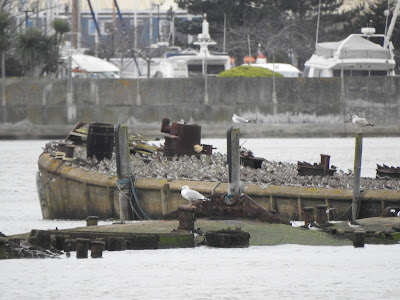A six metre high tide. We're in the springs. An old historical term that has nothing to do with the spring season we are all dreaming of right now in the mirk of winter. Spring tides refer to water "springing forth." They come like clockwork. Two sets every lunar month, when the moon is full, or new, when the moon's monthly orbit has aligned with the sun, and their gravitational forces work in unison.
The opposite is a neap tide. Olde English, nēpflōd, when the moon's monthly orbit is out of synch with the sun, and the gravitational forces are not working in unison - the tides are nipped.
A low neap here can come in around the 4.8 metre mark, a high spring, 6.2, 6.3 metres. Many of our roosts go under on springs, and birds have to change behaviours.
-----
But whilst we all learn about the tides, from schools, from documentaries, from other birders, we rarely hear of other elements that play a major part in the final height of a tidal cycle. One being the surge.
When weather is fair, air pressure is high, and pushes down on the lunar tidal bulge. Tides come in lower than forecast.
When weather is foul, air pressure is low, and allows the lunar tidal bulge to increase. Tides race in higher than forecast.
During my decade back birding on the Medway, there have routinely been surges of up to about half a metre, sometimes a metre, rarely up to a metre and a half. But surge peaks do not often align with the actual high tide, or low; the peaks usually come a little before (and can sometimes mean the highest point of a tidal cycle comes before the forecast high tide),
To work the high efficiently on the Medway, you have to study surge forecasts.
----
Monday.
Fairmile wharf isn't a site that attracts many birders. I haven't bumped into one there yet. Sure, they will visit, I might only get there a handful of times over a tidal cycle, it's just that I haven't seen one yet. There are better honeypots next door for the the general birder.
But once you appreciate you have a fair sightline to the estuary head, and a decent but distance view to the eastern boundary of the estuary at the Sheppey bridges (and you're that way inclined!), you realise a good spot to study flightlines.
Plus there's a roost on view; the old concrete barges just east of the Strand. General rule of thumb, more often used through the high tide on neaps than springs. Today proved an exception, and it was fun to watch the public stopping to enjoy the show.
----
Me? All about those flightlines. On a spring they usually depart north-east. Not today, the majority stayed. Those that did move went more east- south-east. Why?
The roosts to the east, on Nor and Friars, and in Sharps Green Bay on the wrecks, usually have room for latecomers. And often stay, in small part, available. January, wader numbers peak and surges put some sites under water. A combination the day before of not much room at the inn, and not many desirable locations. Then the birds make for Hoo, and to a lesser extent, Darnet.
Both were busy. Why risk/reward prompts individuals to stay longer at a site close to what can be a busy marina/shoreline. Even when a potential 'threat' (a crow) landed, instead of moving off they held on, at a distance.
Individuals making assessments. Part of their choice is based on the assessments of others around them, but there is no real flock mentality. They are making the best of what is available, and their choices are limited by the surge.
There is also chance. The wind is strong, from the north-west, and why waste energy fighting it when there is a chance of some room along the way? They can see congeners up, wing flashing at distance. Try their luck, hope for the best.
Wrecks like these are important. Hoo island was reprofiled and raised up a few years back and should see out the other islands as they fall to sea rise, but right now isn't wet enough to appeal greatly. At a glance, a sea of pampas. There are some pools, but the important bit for now is jost off the island itself, in the north-east corner; saltings surrounded by wrecks.
The birds that had chosen the Strand's line of concrete barges saw out the top of the tide. Win. Every surge a battle to be won. And the battles are coming more frequently.




No comments:
Post a Comment
I've been told not all comments are publishing. There seems to be a problem between Blogger and Chrome, and I'm being told if you have a problem you should try a different search engine.
All a pain in the proverbial. Sorry! I'm a luddite/technophobe (still won't even have a mobile phone) so much else is beyond me..
If still doesn't work, pls send me a DM/post to my twitter a/c @dunnokev to let me know- thanks! Kev 18/12/21